|

Purcell and Elmslie, Architects
Firm active :: 1907-1921
Minneapolis, Minnesota :: Chicago,
Illinois
Philadelphia, Pennsylvania :: Portland, Oregon |
 Navigation ::
Home ::
Grindstone
Navigation ::
Home ::
Grindstone
Ye Older Grindstones
7/4/2006
|
Passageways 3.
Happy Independence Day. Finally got
through the keystrokes for William Gray
Purcell, Part III of the "Preliminary
Draft on 'P & E' Thesis. Thank the extra day of the Fourth of
July holiday weekend. Being a web worker may have similar dynamics to
being sex worker in some ways. When the opportunity to work comes up, it
has to be done right then and there. While I am grateful for the vital, if
not yet sufficient income that arises from doing other web sites, that
means new input here has to slow down in accommodation.
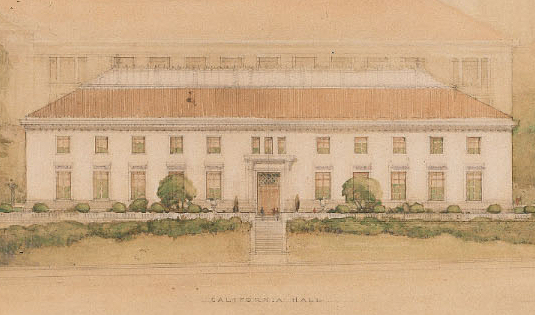 |
California
Hall, University of California Berkeley
John Galen Howard, architect 1905
William Gray Purcell, Clerk of the Works
Image source: Online Archive of
California |
Purcell continues to pay homage those who
employed him during the two years of his apprenticeship, recollecting in
this chapter his work in the Berkeley office of John Galen Howard. In
doing so, he paints himself into something of a corner. Howard was trained
at the Ecole des Beaux Arts in Paris, and had come west from New York after winning
fourth [Purcell says second] prize in the competition sponsored by Phoebe A. Hearst for the
University of California campus at Berkeley. [Those who follow the
machinations of the George Hearst character on Deadwood can easily
appreciate how his wife sought to redeem the family name by supporting the
arts and education as much as she did.]
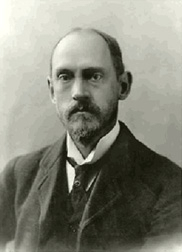
John Galen Howard
Ca. 1900s |
In spring of 1905,
Purcell moved from the Howard office above the old Berkeley post
office to the new atelier in the freshly completed the First National
Bank Building designed by Howard. Images
source: Berkeley Heritage web site. |
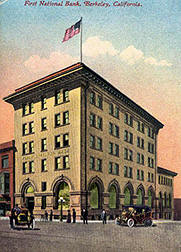
First National Bank Building
John Galen Howard, Architect
Berkeley, California 1905 |
After delivering pages of encomium concerning the
character of John Galen Howard, Purcell must then resolve the latterly
revealed history of how Howard, with some apparently brutal tactics, caused the
removal of Bernard Maybeck (1862-1957) from the architectural school
at Berkeley where he had taught since 1894 and was first professor of
architecture from 1898 until being shoved in 1903.
In the end, all Purcell can do is admit that Howard was a
true Bozarter, and his actions have to be viewed in that context. We are
left to consider that Howard believed his way was right and
intended a greater good from what he did. Out, out damned Maybeck!
Maybeck had a good final word when he said, "I've never thought of myself
as an architect. I just like one line better than another." The raw
difference between Bozart ego and the humility of Everyman in organic design is
patently revealed (we'll leave aside FLLW for the purpose of making a
point).
| A more practical
demonstration of the differences between organic design and the
"pastry" of Beaux Art appliqu occurred with construction of the
307 foot high Jane
K. Sather Tower, also known as The Campanile for the housing of a
carillon that has accumulated 61
bells over the years. Designed, or more appropriately said copied
from the tower in Venice, in 1914 and completed three years later, there
was a wee problem. The exterior wall of the tower was granite,
and this had been attached directly to the interior concrete walls of the
structure without consideration that the two materials might have
different expansion coefficients.
Over time in the hot California
sunshine, direct contact between the two elements resulted in
dangerous cracking and flaking of granite shards, which plummeted to
earth or upon the head of the inadvertent pedestrian. The problem
emerged in the 1940s. Purcell published an essay by architect Jacob
Stone in Northwest Architect where the basic materials error
was revealed, despite every effort taken in the design of the steel
framework and foundations to resist earthquake damage.
A PDF of
the article has been created with some demo software (opens a new
browser window for easier return), and it makes for some very
interesting reading. |
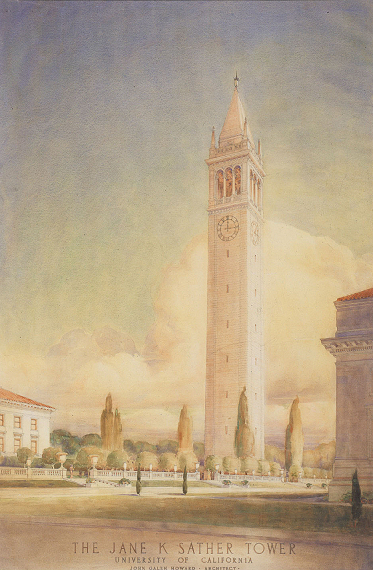
Presentation rendering
Jane K. Sather Tower (The Campanile)
John Galen Howard, Architect
University of California Berkeley 1914
Image source: Online Archive of
California |
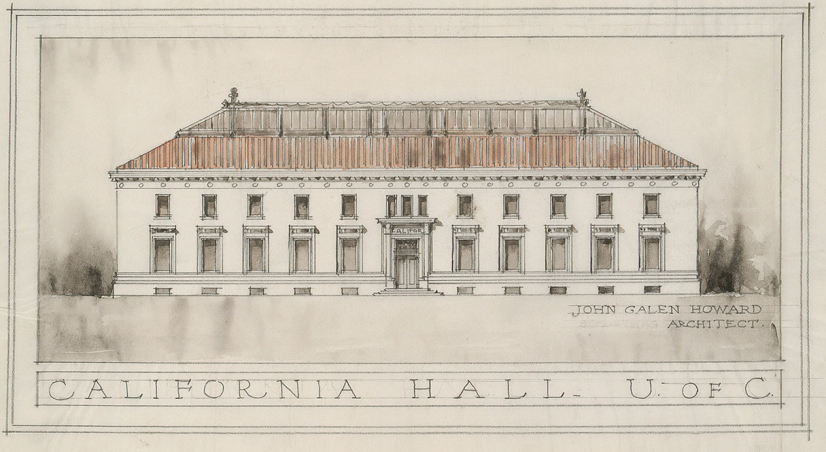
Presentation sketch, possibly
attributable to William Gray Purcell
California Hall,
University of California Berkeley
John Galen Howard, architect 1905
William Gray Purcell, Clerk of the Works
Image source: Online Archive of
California |
An interesting drawing comes to hand through the offering by Online Archive of
California (OAC) of images from the John Galen Howard collection.
Purcell writes that his principal occupation as Clerk of the Works for
California Hall was drawings. One drawing is, by my eye, definitely
lettered by Purcell. Although the format of the drawing is standard issue
Bozart watercolor and pencil technique, the similarity to others from this
period and also those done by Purcell while still at Cornell is plainly
visible. You can just make out that the word "supervising" was erased, as
"Supervising Architect" was the title under which Howard was employed and
his salary paid by Phoebe Hearst.
In the upcoming chapter, after a brief
riff on the "Bay window" phenomenon he saw in San Francisco during his
apprenticeship years, Purcell starts to deal with specific P&E projects in
earnest and discusses the participation of the office staff.
Next up:
William Gray Purcell, Part IV |
7/11/2006
|
Passageways 4.
Continuing our learning curve through
the autobiographical "Preliminary Draft on 'P &
E' Thesis, we come to William Gray
Purcell, Part IV. With the soup and salad of his apprenticeship still
working, Purcell starts placing the meat of the P&E entree on the table.
In this chapter, which was never converted from the third person as
originally generated for David Gebhard, he talks about the demand on Bay
Area architects made by young people seeking a discrete corner in which to
sit closer together -- bay windows with seats, regardless of how the
extrusion of space might disturb the composition of the whole building.
Then we get to an important discussion
about an arc of P&E history, which Purcell described as "a demonstration
of architectural design as a continuity of experience," that resulted many
years down the line in the
Louis Heitman residence. Purcell always loved the
romantic massing of a steep pitched roof. Even from his earliest years as
a designer, he looked for opportunities to use this form. Although he
doesn't mention so here in this draft, there was a house project in
1905, probably more of a sketch for fun than an actual proposed building,
for one Oliver W. Esmond of Berkeley that illustrates perfectly Purcell's
simultaneous fascination and problem.
I have no illustration to offer here of this obscure pencil drawing, which
is large and slightly torn as I recall, but it is a fantasy confection,
more like an infestation, of dormers. Such, in fact Purcell tells us, is
the very core of the issue with this particular approach:
"Purcell kept coming back to this form
in early Catherine Gray studies,
1907 (Purcell and Feick job #4-1/2) but
rejected them. In the Minneapolis climate the idea kept developing snow
pockets. The wedge was plainly tied to rectangular plans with no Ls and
no jogs greater than the width of the broad eaves. Steep roof designs
seemed to get complicated and ultimately wholly out of control too many
dormers." (*)
As I wrote in the
Minnesota 1900 essay:
"For the first time,
Purcell was faced with initiating and sustaining responsibility for the
building process from beginning idea through construction, something that
until then had been only theory for him. A group of four sketches that are
the earliest known drawings for this project provide insight into his
difficulties. He approached the problem from a variety of fronts,
experimenting with the possible compositional effects of a high-pitched or
low-hipped roof treatment. The floor plans of the house evolved more
stubbornly. In the first effort Purcell revealed his lifelong attraction to
the aspiration of a high-pitched roof. The plan, however, would have
none of it. The pitch of the roof subsides quickly across the sequence of
sketches, with two intermediate dormer ideas finally disappearing entirely in
the fourth version."
Purcell recounts the next time he had an
opportunity to pursue the form as being a project for
the
A. D. Hirschfelder residence (Minneapolis, Minnesota
1915). This time the project got to working drawings, but the wife of the
client wasn't buying -- and wasn't giving any leverage, much to the
disappointment of her husband who was all for the game plan.
The idea turns up again in the
Charles T. Backus residence (Minneapolis, Minnesota 1915).
According to Purcell in his Parabiographies
entry, Marion Parker and he were responsible for the
design as Elmslie was busy elsewhere at the time. How ironic that the
client gave a total no to the idea, because in his going to Lake Place to
tune Purcell's piano he had fallen in love with the flat roof and other
elements of that design and wanted his own house to be as close as
possible a realization of those lines. Again, Purcell was thwarted.
Then comes opportunity. The first scheme
for the Louis Heitman residence,
as
Purcell recounts, had been shelved because of cost. After an interim
of five years, the Heitmans show up in Minneapolis and are ready to look
again on the notion that they want to move, as sometimes clients do,
right then. Purcell pulls out the canned Hirschfelder drawing set, tips his hand
toward a
steep pitched roof, and with the obligatory "small changes" to
personalize the place for the Heitmans that result in
a completely new set of working drawings, lo, finally, hosanna. The result is a
house that Purcell credits as one of the three most significant ever done
by the firm, right after Lake Place and the
Josephine Crane Bradley residence #2 (Madison, Wisconsin
1914). How important a judgment on his part is that!
Purcell finishes up this
chapter with praise for the foreman who supervised construction,
August Lennartz. Lennartz was with P&E
from 1910 right up through the beginning of World War I. He would have
been the one going to China to supervise building of the
Institutional
Church for Charles O. Alexander,
also known as the Y.M.C.A. project. A few years ago I had the honor to dine
privately at Taliesin with one of the pre-eminent archaeologists in
China, and his wife, a classical scholar who is also a grand-daughter
of one of the last ceremonial empresses of Chinese Imperial court. They
kindly translated the characters on the rendering prepared by P&E:
"In this beautiful place where the
gods themselves would choose to dwell, rises our heavenly temple."
Surely, no doubt, they would. |
|
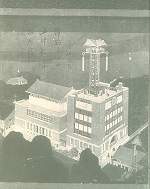
Institutional Church for Charles O. Alexander, project
also known as "Y.M.C.A"
Siang Tan,
Hunan, China 1916 |
Next up:
William Gray Purcell, Part V
|
7/21/2006
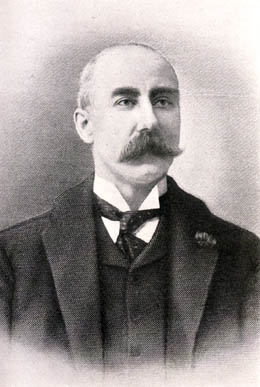
Charles H. Bebb
1856-1942
Image source:
HistoryLink.org |
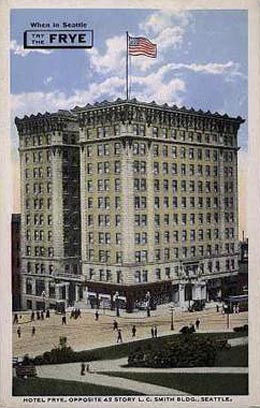
Frye Hotel
Bebb and Mendel, Architects
Seattle, Washington 1911
Image source:
HistoryLink.org |
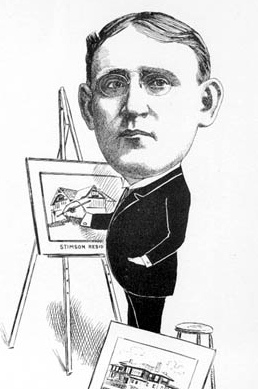
Louis Mendel
1867-1940
From a cartoon in Argus, ca. 1906
Image source:
HistoryLink.org |
Passageways 5.
In typing our passage through more pages of the "Preliminary Draft on 'P &
E' Thesis, we come to William Gray
Purcell, Part V. Purcell continues taking breath in Berkeley, where we can
conclude with fair certainty is where he caught the tuberculosis that
would, as he describes, "the slow cloud which more than any other factor
was to shape my whole life." Then, even though still wanted at John
Galen Howard's office where he had just overseen the test pits for the
next big campus building, the Library, he determines to move on. Purcell
reports a happy life in Berkeley, but the westering urge was as yet unsatisfied and
required a northern veer to Seattle.
Purcell was there in Washington state
once before, in 1900, on his trip north with his father and brother on an
exciting vacation adventure to the gold fields and Alaska. As he admits,
this environment proved a strange combination of choice and desire for his
own wellbeing. He went west for the warm sunshine, and wound up north in
the chilly rain because that's where he always wanted to be. Bidding adieu
to Walter Ratcliff, Jr., his English-born friend in Howard's office who
wanted to start a business with him, Purcell took a lonely, tossing ship
voyage poleward, sleeping on deck and having "no will to eat." How well
indeed the journey foreshadowed his life experience yet to unfold in that
geographical corner of America just a decade later, ending finally in his
flight back to the sun and the Pottenger Sanatorium in Banning,
California. Pure organic poetry, clef.
A quick stop at the architectural office
of Bebb and Mendel and Purcell got an instant hire from Charles Herbert
Bebb (1856-1942), the now leading Seattle architect who served as
supervising architect for Adler & Sullivan on the Auditorium Building.
Bebb came out to the Pacific Northwest when Adler & Sullivan had prospects
of an opera hall, and following a brief return to Chicago he returned
Seattle to stay after that first siren project evaporated. His partnership
with Louis Mendel (1867-1970) had an age difference with Bebb similar to
that between Purcell and Elmslie, and Bebb and Mendel joined in prosperous
practice from 1901 to 1914. Curiously, the younger Mendel departed to
maintain a small boutique practice, while Bebb went on to scale great
commercial Bozart heights with another partner, Carl F. Gould (1873-1939).
Purcell reports the Bebb and Mendel
office was full of "experts," and he was armed only with his "enthusiasm."
History would prove this as an office intent on the business of
architecture, that is making the architect serious money while cultivating
the mantle of social respect that leads, most likely, to additional
opportunities to make bank, and perhaps bank buildings, over lunch at the right club. Purcell was a
fish out of water. Undoubtedly his reference of service in the
Sullivan office had gotten him in the door, but the opportunity turned out
to offer two weeks to look for another job and leave before "being fired."
That brought him to his stint in the
office of architect A. Warren Gould, with a "fifty percent" raise in the process.
Interestingly, Purcell does not have two words to say about the principal
of the firm, but instead chats up a downtrodden office character he
befriended and sought to rescue. The Seattle residency ended in what might
be considered something of a clever family intervention. Purcell was
enticed to a winter vacation at the Grand Canyon by his doting grandmother
Catherine Gray and her companion Annie Ziegler (a faithful woman who
honored for some thirty years a pledge to W. C. Gray to stay with his widow). The two women went back to Seattle with Purcell, and his father
coincidentally also shows up fretting as usual about his son's health.
As Purcell recounts it here in these pages (and it varies a little
elsewhere in the telling but is essentially the same story), his father
offers a trip to Europe and he packs up, heads toward Chicago under the
umbrella of better weather, and makes for the Konig Albert, a German
steamer about to sail from New York.
Purcell's attraction to the Pacific
Northwest area very likely originated in his idyllic experiences at Island
Lake, where his grandfather was reliving -- right down to the architecture
-- the pioneering life in which he had been raised on the Gray farm in
Ohio in the 1840s. The log cabins and Indians were still within arm's
reach, even if Purcell could only afford to buy an occasional breakfast at
the best restaurant in town. Much of Purcell's life was spent in emulation
of his grandfather, and his descendent quest for the ideal life he
experienced as a child at the family camp in northern Wisconsin always
required trees and water.
In the next section Purcell takes us
along on his year long travels with George Feick, Jr., in Europe and the
Near East.
Next up:
William Gray Purcell, Part VI |
 research courtesy mark hammons
research courtesy mark hammons
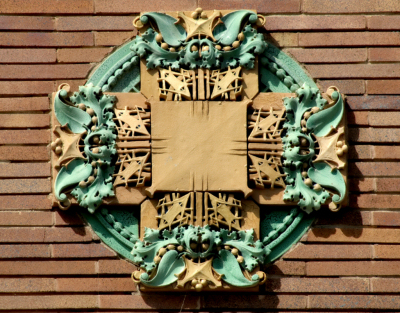
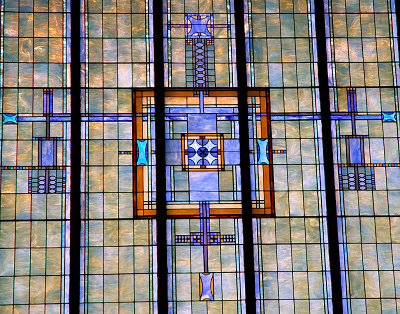





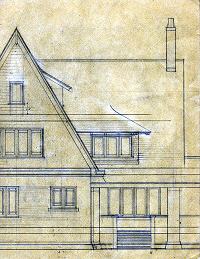
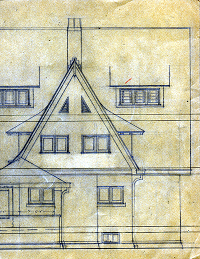
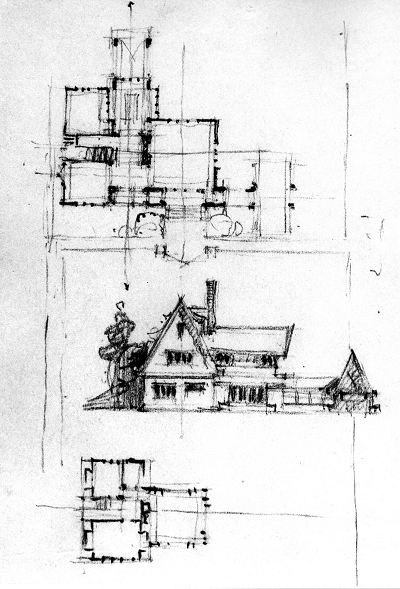
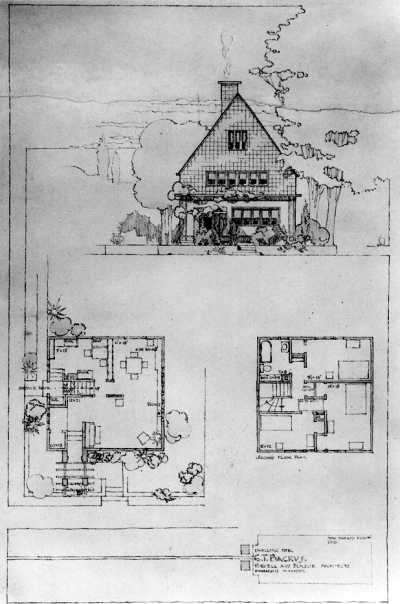
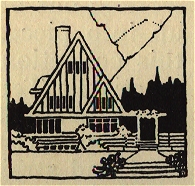
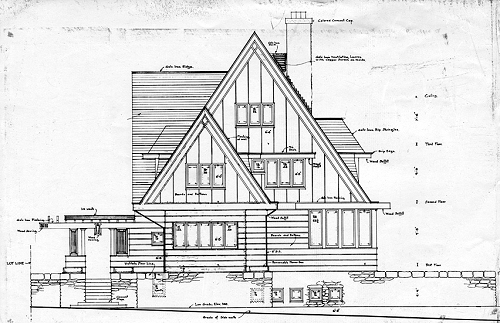



![]() research courtesy mark hammons
research courtesy mark hammons